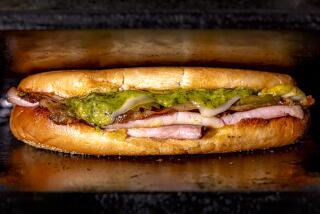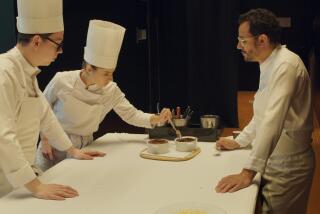French Trucker Dining
- Share via
If you believe a well-worn bit of folk wisdom, on the road you’ll look for restaurants with oil-stained parking lots. Stains among the cars indicate a lot of truck traffic, and truck drivers, according to this 20th-Century maxim, know where to find good, inexpensive food.
In this country, sad to say, most truckers have forsaken the home-style meals of Cookie’s Diner for the gloppy fast-food burgers at franchises whose jingles play on their radios all day.
In France, things are different. Food is a religion, and even truck drivers are observant.
True, plastic-food chains now rule France’s auto routes. But, all over the country, on the N-roads (the old national routes heavily used by truckers) and the smaller D-roads (the scenic departmental or secondary roads connecting small towns), thousands of little family-run restaurants are still patronized by truck drivers and locals who want a well-prepared, inexpensive and traditionally leisurely French meal.
A Bit of Courage
Travelers with just a bit of courage can join them. All that’s needed is an understanding of the relais routiers . In English we’d call them “truck stops,” but that harsh phrase doesn’t do justice to the concept.
In 1934 the newspaper of Les Routiers, a French truck drivers’ union, devoted a couple of pages to a list of favored eateries. Soon a restaurant network was formed and a booklet was published, for members only. For more than three decades, drivers used the book--in increasingly heftier editions--to find relais that displayed a red-and-blue shield with the union’s name in white. Then the book went public.
Now, savvy travelers in search of simple, hearty road food have learned to watch for the union sign and rely on the annual “Guide des Relais Routiers,” which lists 4,000 places by town and plots them on helpful regional maps. Smart tourists, French and foreign, don’t leave home without it.
To be listed in the guide, restaurants must meet the truck driver’s notion of a proper meal: good food in big portions at reasonable prices. This translates to a fixed-price home-cooked meal of three copious courses (sometimes with wine thrown in) for about $4 or $5, including tip.
At some places the prix-fixe special is the cheapest offering on the list, with two or three costlier meals and an a la carte menu available. At others, there is one price and just two or three choices of appetizer and main dish. At the smallest there is only a set meal, like visiting a French grandmother.
In each of several driving tours of France, my wife and I have made it a practice to lunch often at relais routiers , saving evening meals for more ambitious dining. Invariably, we’ve been happy.
Ample Portions
Never have we been served portions that were less than ample. Despite the healthy appetites of active sightseers, we have frequently found ourselves leaving behind a pile of uneaten vegetables or a half-full bread basket. And, because one way that relais owners keep costs down is by relying on whatever is in season and locally abundant, the food has always been remarkably fresh. And some of the dishes have been first-rate.
There were the spicy tomates provencales that came with the daube (a kind of beef stew) at Le Relais du Passage a Niveau on the Route de Tarascon in Arles not far from Marseillle.
And the memorable soupe de poisson we had one rainy, foggy day on the coast of Normandy, in one of several small stucco rooms that make up Au Vieux Normand, just outside of Le Bas Cabourg on the road to Caen. The soup, an a la carte splurge, came in a huge tureen with freshly grated cheese and a plate of big, chunky croutons on the side.
There was the skillet-fried fish with pommes frites at the Auberge de la Colline, just off Route N7 in Bedarrides near Orange, site of a noteworthy 1,800-year-old Roman theater. This relais is one of 120 honored with a tiny drawing of a casserole after its listing in the guide, the relais routiers equivalent of a Michelin star, indicating top-quality cooking and particular emphasis on regional specialties.
Burgundy Vineyards
Lunch on a summer Sunday at the Hotel de la Croix Blance, on Route N455 in Senan, was amid the lush vineyards of Burgundy. In a long, plain room, several tables had been pushed into a row and covered with flowered oilcloth. We ate just-ripe melon, pate, tender and juicy lamb, mounds of beans and bread, three kinds of cheese and fresh fruit.
Our companions at the long table were three or four drivers and several local families having a Sunday meal out, including one couple with a small dog, which they parked at their feet. We felt as if we were watching the whole village, and, of course, the whole village was watching us.
Only once have we found a welcome that was less than friendly. We pulled into a relais in La Roque d’Antheron, a bit south of the Luberon Mountains of Provence, just as the clock struck two. The patron barely looked up as we entered.
“Termine!” he snapped. “Why don’t you eat at noon like everybody else?” He turned back to clearing the dishes from his last customers, teaching us that family-run places often have limited hours (usually from noon to 2 for lunch) and that late isn’t always better than never. We found an open epicerie nearby and managed with a makeshift picnic.
In our forays we learned that some relais have separate dining rooms--with higher prices--for tourists. (Drivers, for instance, may be given a quarter liter of wine on the house, while tourists pay 4 or 5 francs extra.) At these, the owners will try to steer outsiders away from the drivers’ area, pointing out the quieter, prettier room in back with real tablecloths and starched napkins. If you want the bargain and, above all, the ambiance, insist on sitting with the drivers.
Dress Simply
Keep your dress simple; most of the customers will be drivers or locals on their lunch breaks, not Beautiful People out to be seen.
Women should be prepared to be the object of attention, though never of rudeness. (If there’s a woman seated with them, for example, drivers may refuse to begin eating until she has helped herself.)
And despite a growing number of foreigners using the guide, most proprietors speak only French, so be prepared to order--or at least try--in their language. Pack a dictionary if you need it.
Establishments do pay for their listings in the guide, and for the right to display the red, blue and white shield. But 10 full-time inspectors continually check on the restaurants, and truck drivers and tourists alike are encouraged to file reviews of food and service. Each year, according to Thierry de Saulieu, the book’s editor, scores of relais lose their Les Routiers shield for failing to live up to standards.
Going the relais routiers way is not for travelers in search of only the well-known, only the highest of the haute cuisine. It is not for those who insist that every step of their travels be perfectly reliable, predictable and safe. But, for the mildly adventuresome, it can lead to good, simple eating places off the beaten path. It can keep costs down. It can add an extra dimension to a trip.
Many of the relais routiers offer overnight lodging for truckers and European tourists, but the accommodations are not designed to make middle-class Americans happy. Stick to the dining rooms, where you’ll find what a French journalist called an “astonishing mixture of friendliness, red wine, axle grease and Camembert.”
The “Guide des Relais Routiers,” published early each spring, includes an English introduction. The book is sold in the United States for $14.95 at the Librairie de France, 610 Fifth Ave., New York 10020. The Librairie accepts mail orders but requires a minimum order of $20 and charges $4.50 for shipping. If you wait until you hit French soil, you can find the book at many bookstores for about $5.
More to Read
Sign up for The Wild
We’ll help you find the best places to hike, bike and run, as well as the perfect silent spots for meditation and yoga.
You may occasionally receive promotional content from the Los Angeles Times.






